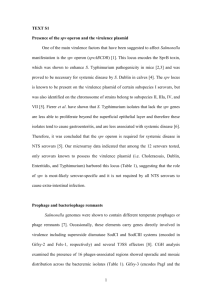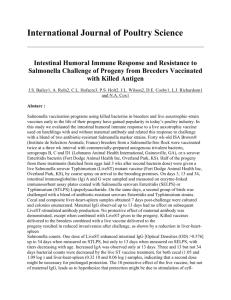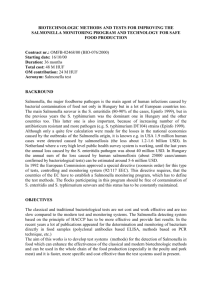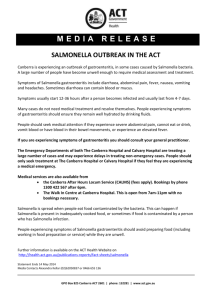Supplemental References
advertisement
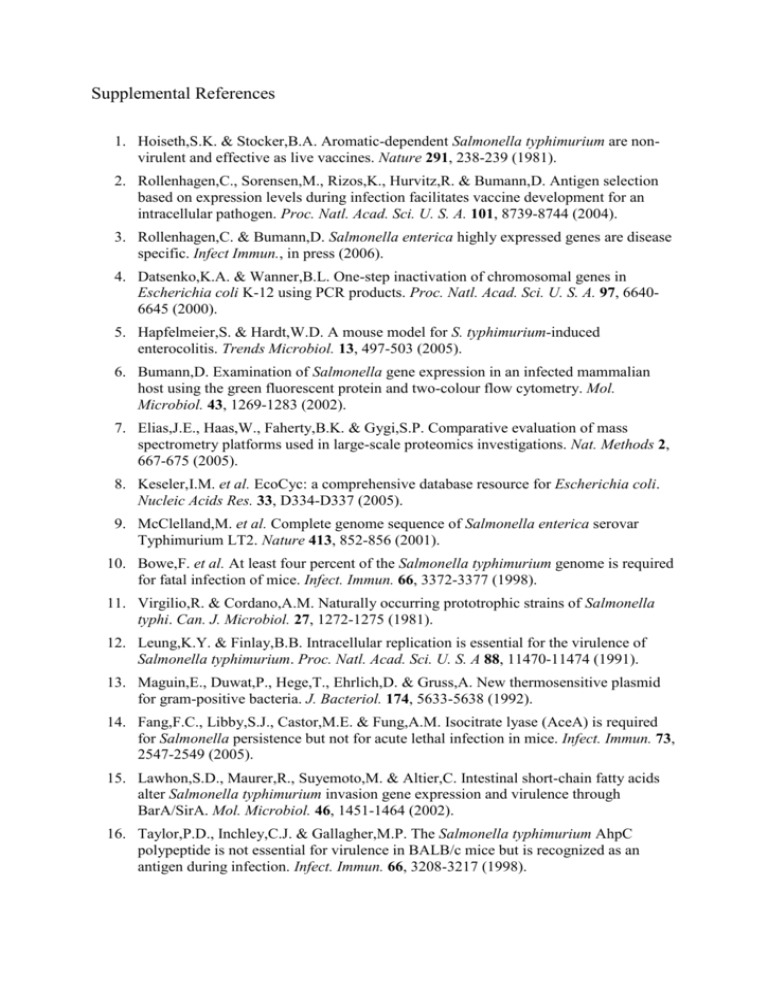
Supplemental References 1. Hoiseth,S.K. & Stocker,B.A. Aromatic-dependent Salmonella typhimurium are nonvirulent and effective as live vaccines. Nature 291, 238-239 (1981). 2. Rollenhagen,C., Sorensen,M., Rizos,K., Hurvitz,R. & Bumann,D. Antigen selection based on expression levels during infection facilitates vaccine development for an intracellular pathogen. Proc. Natl. Acad. Sci. U. S. A. 101, 8739-8744 (2004). 3. Rollenhagen,C. & Bumann,D. Salmonella enterica highly expressed genes are disease specific. Infect Immun., in press (2006). 4. Datsenko,K.A. & Wanner,B.L. One-step inactivation of chromosomal genes in Escherichia coli K-12 using PCR products. Proc. Natl. Acad. Sci. U. S. A. 97, 66406645 (2000). 5. Hapfelmeier,S. & Hardt,W.D. A mouse model for S. typhimurium-induced enterocolitis. Trends Microbiol. 13, 497-503 (2005). 6. Bumann,D. Examination of Salmonella gene expression in an infected mammalian host using the green fluorescent protein and two-colour flow cytometry. Mol. Microbiol. 43, 1269-1283 (2002). 7. Elias,J.E., Haas,W., Faherty,B.K. & Gygi,S.P. Comparative evaluation of mass spectrometry platforms used in large-scale proteomics investigations. Nat. Methods 2, 667-675 (2005). 8. Keseler,I.M. et al. EcoCyc: a comprehensive database resource for Escherichia coli. Nucleic Acids Res. 33, D334-D337 (2005). 9. McClelland,M. et al. Complete genome sequence of Salmonella enterica serovar Typhimurium LT2. Nature 413, 852-856 (2001). 10. Bowe,F. et al. At least four percent of the Salmonella typhimurium genome is required for fatal infection of mice. Infect. Immun. 66, 3372-3377 (1998). 11. Virgilio,R. & Cordano,A.M. Naturally occurring prototrophic strains of Salmonella typhi. Can. J. Microbiol. 27, 1272-1275 (1981). 12. Leung,K.Y. & Finlay,B.B. Intracellular replication is essential for the virulence of Salmonella typhimurium. Proc. Natl. Acad. Sci. U. S. A 88, 11470-11474 (1991). 13. Maguin,E., Duwat,P., Hege,T., Ehrlich,D. & Gruss,A. New thermosensitive plasmid for gram-positive bacteria. J. Bacteriol. 174, 5633-5638 (1992). 14. Fang,F.C., Libby,S.J., Castor,M.E. & Fung,A.M. Isocitrate lyase (AceA) is required for Salmonella persistence but not for acute lethal infection in mice. Infect. Immun. 73, 2547-2549 (2005). 15. Lawhon,S.D., Maurer,R., Suyemoto,M. & Altier,C. Intestinal short-chain fatty acids alter Salmonella typhimurium invasion gene expression and virulence through BarA/SirA. Mol. Microbiol. 46, 1451-1464 (2002). 16. Taylor,P.D., Inchley,C.J. & Gallagher,M.P. The Salmonella typhimurium AhpC polypeptide is not essential for virulence in BALB/c mice but is recognized as an antigen during infection. Infect. Immun. 66, 3208-3217 (1998). 17. Coynault,C., Robbe-Saule,V. & Norel,F. Virulence and vaccine potential of Salmonella typhimurium mutants deficient in the expression of the RpoS (sigma S) regulon. Mol. Microbiol. 22, 149-160 (1996). 18. Hone,D.M. et al. Evaluation in volunteers of a candidate live oral attenuated Salmonella typhi vector vaccine. J. Clin. Invest 90, 412-420 (1992). 19. Gunel-Ozcan,A., Brown,K.A., Allen,A.G. & Maskell,D.J. Salmonella typhimurium aroB mutants are attentuated in BALB/c mice. Microb. Pathog. 23, 311-316 (1997). 20. Cano,D.A., Pucciarelli,M.G., Martinez-Moya,M., Casadesus,J. & Garcia-Del Portillo,F. Selection of small-colony variants of Salmonella enterica serovar typhimurium in nonphagocytic eucaryotic cells. Infect. Immun. 71, 3690-3698 (2003). 21. Turner,A.K. et al. Contribution of proton-translocating proteins to the virulence of Salmonella enterica serovars Typhimurium, Gallinarum, and Dublin in chickens and mice. Infect. Immun. 71, 3392-3401 (2003). 22. Mouslim,C., Delgado,M. & Groisman,E.A. Activation of the RcsC/YojN/RcsB phosphorelay system attenuates Salmonella virulence. Mol. Microbiol. 54, 386-395 (2004). 23. Tacket,C.O. et al. Comparison of the safety and immunogenicity of delta aroC delta aroD and delta cya delta crp Salmonella typhi strains in adult volunteers. Infect. Immun. 60, 536-541 (1992). 24. Miki,T., Okada,N. & Danbara,H. Two periplasmic disulfide oxidoreductases, DsbA and SrgA, target outer membrane protein SpiA, a component of the Salmonella pathogenicity island 2 type III secretion system. J. Biol. Chem. 279, 34631-34642 (2004). 25. Tsolis,R.M., Baumler,A.J., Heffron,F. & Stojiljkovic,I. Contribution of TonB- and Feo-mediated iron uptake to growth of Salmonella typhimurium in the mouse. Infect. Immun. 64, 4549-4556 (1996). 26. Stojiljkovic,I., Baumler,A.J. & Heffron,F. Ethanolamine utilization in Salmonella typhimurium: nucleotide sequence, protein expression, and mutational analysis of the cchA cchB eutE eutJ eutG eutH gene cluster. J. Bacteriol. 177, 1357-1366 (1995). 27. Boyer,E., Bergevin,I., Malo,D., Gros,P. & Cellier,M.F. Acquisition of Mn(II) in addition to Fe(II) is required for full virulence of Salmonella enterica serovar Typhimurium. Infect. Immun. 70, 6032-6042 (2002). 28. Rabsch,W. et al. Role of receptor proteins for enterobactin and 2,3dihydroxybenzoylserine in virulence of Salmonella enterica. Infect. Immun. 71, 69536961 (2003). 29. Murray,G.L., Attridge,S.R. & Morona,R. Regulation of Salmonella typhimurium lipopolysaccharide O antigen chain length is required for virulence; identification of FepE as a second Wzz. Mol. Microbiol. 47, 1395-1406 (2003). 30. Humphreys,S. et al. Role of periplasmic peptidylprolyl isomerases in Salmonella enterica serovar Typhimurium virulence. Infect. Immun. 71, 5386-5388 (2003). 31. Hone,D., Morona,R., Attridge,S. & Hackett,J. Construction of defined galE mutants of Salmonella for use as vaccines. J. Infect. Dis. 156, 167-174 (1987). 32. Hone,D.M. et al. A galE via (Vi antigen-negative) mutant of Salmonella typhi Ty2 retains virulence in humans. Infect. Immun. 56, 1326-1333 (1988). 33. Klose,K.E. & Mekalanos,J.J. Simultaneous prevention of glutamine synthesis and high-affinity transport attenuates Salmonella typhimurium virulence. Infect. Immun. 65, 587-596 (1997). 34. McFarland,W.C. & Stocker,B.A. Effect of different purine auxotrophic mutations on mouse-virulence of a Vi-positive strain of Salmonella dublin and of two strains of Salmonella typhimurium. Microb. Pathog. 3, 129-141 (1987). 35. Kim,C.C., Monack,D. & Falkow,S. Modulation of virulence by two acidified nitriteresponsive loci of Salmonella enterica serovar Typhimurium. Infect. Immun. 71, 31963205 (2003). 36. Benjamin,W.H., Jr., Hall,P. & Briles,D.E. A hemA mutation renders Salmonella typhimurium avirulent in mice, yet capable of eliciting protection against intravenous infection with S. typhimurium. Microb. Pathog. 11, 289-295 (1991). 37. Jones,B.D., Nichols,W.A., Gibson,B.W., Sunshine,M.G. & Apicella,M.A. Study of the role of the htrB gene in Salmonella typhimurium virulence. Infect. Immun. 65, 4778-4783 (1997). 38. Maier,R.J., Olczak,A., Maier,S., Soni,S. & Gunn,J. Respiratory hydrogen use by Salmonella enterica serovar Typhimurium is essential for virulence. Infect. Immun. 72, 6294-6299 (2004). 39. Buchmeier,N.A. et al. DNA repair is more important than catalase for Salmonella virulence in mice. J. Clin. Invest 95, 1047-1053 (1995). 40. Collins,L.V., Attridge,S. & Hackett,J. Mutations at rfc or pmi attenuate Salmonella typhimurium virulence for mice. Infect. Immun. 59, 1079-1085 (1991). 41. Ejim,L.J. et al. Cystathionine beta-lyase is important for virulence of Salmonella enterica serovar Typhimurium. Infect. Immun. 72, 3310-3314 (2004). 42. De Groote,M.A., Testerman,T., Xu,Y., Stauffer,G. & Fang,F.C. Homocysteine antagonism of nitric oxide-related cytostasis in Salmonella typhimurium. Science 272, 414-417 (1996). 43. Blanc-Potard,A.B. & Groisman,E.A. The Salmonella selC locus contains a pathogenicity island mediating intramacrophage survival. EMBO J. 16, 5376-5385 (1997). 44. Low,K.B. et al. Lipid A mutant Salmonella with suppressed virulence and TNFalpha induction retain tumor-targeting in vivo. Nat. Biotechnol. 17, 37-41 (1999). 45. Baumler,A.J., Kusters,J.G., Stojiljkovic,I. & Heffron,F. Salmonella typhimurium loci involved in survival within macrophages. Infect. Immun. 62, 1623-1630 (1994). 46. Spector,M.P. et al. The rpoS-dependent starvation-stress response locus stiA encodes a nitrate reductase (narZYWV) required for carbon-starvation-inducible thermotolerance and acid tolerance in Salmonella typhimurium. Microbiology 145, 3035-3045 (1999). 47. Dorman,C.J., Chatfield,S., Higgins,C.F., Hayward,C. & Dougan,G. Characterization of porin and ompR mutants of a virulent strain of Salmonella typhimurium: ompR mutants are attenuated in vivo. Infect. Immun. 57, 2136-2140 (1989). 48. Meyer,P.N., Wilmes-Riesenberg,M.R., Stathopoulos,C. & Curtiss,R., III. Virulence of a Salmonella typhimurium OmpD mutant. Infect. Immun. 66, 387-390 (1998). 49. Howells,A.M. et al. Role of trehalose biosynthesis in environmental survival and virulence of Salmonella enterica serovar typhimurium. Res. Microbiol. 153, 281-287 (2002). 50. Mouslim,C., Hilbert,F., Huang,H. & Groisman,E.A. Conflicting needs for a Salmonella hypervirulence gene in host and non-host environments. Mol. Microbiol. 45, 1019-1027 (2002). 51. Valdivia,R.H. & Falkow,S. Fluorescence-based isolation of bacterial genes expressed within host cells. Science 277, 2007-2011 (1997). 52. Gunn,J.S., Ryan,S.S., Van Velkinburgh,J.C., Ernst,R.K. & Miller,S.I. Genetic and functional analysis of a PmrA-PmrB-regulated locus necessary for lipopolysaccharide modification, antimicrobial peptide resistance, and oral virulence of Salmonella enterica serovar typhimurium. Infect. Immun. 68, 6139-6146 (2000). 53. Matsui,H. et al. Virulence plasmid-borne spvB and spvC genes can replace the 90kilobase plasmid in conferring virulence to Salmonella enterica serovar Typhimurium in subcutaneously inoculated mice. J. Bacteriol. 183, 4652-4658 (2001). 54. Tsolis,R.M. et al. Identification of a putative Salmonella enterica serotype typhimurium host range factor with homology to IpaH and YopM by signature-tagged mutagenesis. Infect. Immun. 67, 6385-6393 (1999). 55. Kok,M., Bron,G., Erni,B. & Mukhija,S. Effect of enzyme I of the bacterial phosphoenolpyruvate : sugar phosphotransferase system (PTS) on virulence in a murine model. Microbiology 149, 2645-2652 (2003). 56. O'Callaghan,D., Maskell,D., Liew,F.Y., Easmon,C.S. & Dougan,G. Characterization of aromatic- and purine-dependent Salmonella typhimurium: attention, persistence, and ability to induce protective immunity in BALB/c mice. Infect. Immun. 56, 419423 (1988). 57. Pizarro-Cerda,J. & Tedin,K. The bacterial signal molecule, ppGpp, regulates Salmonella virulence gene expression. Mol. Microbiol. 52, 1827-1844 (2004). 58. Janakiraman,A. & Slauch,J.M. The putative iron transport system SitABCD encoded on SPI1 is required for full virulence of Salmonella typhimurium. Mol. Microbiol. 35, 1146-1155 (2000). 59. Tsolis,R.M., Baumler,A.J. & Heffron,F. Role of Salmonella typhimurium Mnsuperoxide dismutase (SodA) in protection against early killing by J774 macrophages. Infect. Immun. 63, 1739-1744 (1995). 60. Krishnakumar,R., Craig,M., Imlay,J.A. & Slauch,J.M. Differences in enzymatic properties allow SodCI but not SodCII to contribute to virulence in Salmonella enterica serovar Typhimurium strain 14028. J. Bacteriol. 186, 5230-5238 (2004). 61. Kok,M., Buhlmann,E. & Pechere,J.C. Salmonella typhimurium thyA mutants fail to grow intracellularly in vitro and are attenuated in mice. Microbiology 147, 727-733 (2001). 62. Stone,B.J. & Miller,V.L. Salmonella enteritidis has a homologue of tolC that is required for virulence in BALB/c mice. Mol. Microbiol. 17, 701-712 (1995). 63. Parra-Lopez,C., Lin,R., Aspedon,A. & Groisman,E.A. A Salmonella protein that is required for resistance to antimicrobial peptides and transport of potassium. EMBO J. 13, 3964-3972 (1994). 64. Ramos-Morales,F., Prieto,A.I., Beuzon,C.R., Holden,D.W. & Casadesus,J. Role for Salmonella enterica enterobacterial common antigen in bile resistance and virulence. J. Bacteriol. 185, 5328-5332 (2003). 65. Campoy,S. et al. Role of the high-affinity zinc uptake znuABC system in Salmonella enterica serovar typhimurium virulence. Infect. Immun. 70, 4721-4725 (2002). 66. Lundberg,B.E., Wolf,R.E., Jr., Dinauer,M.C., Xu,Y. & Fang,F.C. Glucose 6phosphate dehydrogenase is required for Salmonella typhimurium virulence and resistance to reactive oxygen and nitrogen intermediates. Infect. Immun. 67, 436-438 (1999). 67. Porwollik,S., Santiviago,C.A., Cheng,P., Florea,L. & McClelland,M. Differences in gene content between Salmonella enterica serovar Enteritidis isolates and comparison to closely related serovars Gallinarum and Dublin. J. Bacteriol. 187, 6545-6555 (2005). 68. Deng,W. et al. Comparative genomics of Salmonella enterica serovar Typhi strains Ty2 and CT18. J. Bacteriol. 185, 2330-2337 (2003). 69. Parkhill,J. et al. Complete genome sequence of a multiple drug resistant Salmonella enterica serovar Typhi CT18. Nature 413, 848-852 (2001). 70. McClelland,M. et al. Comparison of genome degradation in Paratyphi A and Typhi, human-restricted serovars of Salmonella enterica that cause typhoid. Nat. Genet. 36, 1268-1274 (2004). 71. Lacroix,F.J. et al. Salmonella typhimurium acrB-like gene: identification and role in resistance to biliary salts and detergents and in murine infection. FEMS Microbiol. Lett. 135, 161-167 (1996). 72. Hardt,W.D. & Galan,J.E. A secreted Salmonella protein with homology to an avirulence determinant of plant pathogenic bacteria. Proc. Natl. Acad. Sci. U. S. A. 94, 9887-9892 (1997). 73. Jones,B.D., Lee,C.A. & Falkow,S. Invasion by Salmonella typhimurium is affected by the direction of flagellar rotation. Infect. Immun. 60, 2475-2480 (1992). 74. Yamamoto,T. et al. Disruption of the genes for ClpXP protease in Salmonella enterica serovar Typhimurium results in persistent infection in mice, and development of persistence requires endogenous gamma interferon and tumor necrosis factor alpha. Infect. Immun. 69, 3164-3174 (2001). 75. Takaya,A., Tomoyasu,T., Matsui,H. & Yamamoto,T. The DnaK/DnaJ chaperone machinery of Salmonella enterica serovar Typhimurium is essential for invasion of epithelial cells and survival within macrophages, leading to systemic infection. Infect. Immun. 72, 1364-1373 (2004). 76. Klose,K.E. & Mekalanos,J.J. Simultaneous prevention of glutamine synthesis and high-affinity transport attenuates Salmonella typhimurium virulence. Infect. Immun. 65, 587-596 (1997). 77. Xu,K., Delling,J. & Elliott,T. The genes required for heme synthesis in Salmonella typhimurium include those encoding alternative functions for aerobic and anaerobic coproporphyrinogen oxidation. J. Bacteriol. 174, 3953-3963 (1992). 78. Chiariotti,L., Alifano,P., Carlomagno,M.S. & Bruni,C.B. Nucleotide sequence of the Escherichia coli hisD gene and of the Escherichia coli and Salmonella typhimurium hisIE region. Mol. Gen. Genet. 203, 382-388 (1986). 79. Higgins,C.F. et al. Complete nucleotide sequence and identification of membrane components of the histidine transport operon of S. typhimurium. Nature. 298, 723-727 (1982). 80. Nilsson,A.I. et al. Bacterial genome size reduction by experimental evolution. Proc. Natl. Acad. Sci. U. S. A. 102, 12112-12116 (2005). 81. Hagen,D.C., Lipton,P.J. & Magasanik,B. Isolation of a trans-dominant histidasenegative mutant of Salmonella typhimurium. J. Bacteriol. 120, 906-916 (1974). 82. Nilsson,A.I., Kugelberg,E., Berg,O.G. & Andersson,D.I. Experimental adaptation of Salmonella typhimurium to mice. Genetics. 168, 1119-1130 (2004). 83. Hisert,K.B. et al. A glutamate-alanine-leucine (EAL) domain protein of Salmonella controls bacterial survival in mice, antioxidant defence and killing of macrophages: role of cyclic diGMP. Mol. Microbiol. 56, 1234-1245 (2005). 84. Riesenberg-Wilmes,M.R., Bearson,B., Foster,J.W. & Curtis,R., III. Role of the acid tolerance response in virulence of Salmonella typhimurium. Infect. Immun. 64, 10851092 (1996). 85. Buchmeier,N.A., Lipps,C.J., So,M.Y. & Heffron,F. Recombination-deficient mutants of Salmonella typhimurium are avirulent and sensitive to the oxidative burst of macrophages. Mol. Microbiol. 7, 933-936 (1993). 86. Hensel,M. et al. Simultaneous identification of bacterial virulence genes by negative selection. Science 269, 400-403 (1995). 87. Folkesson,A. et al. Multiple insertions of fimbrial operons correlate with the evolution of Salmonella serovars responsible for human disease. Mol. Microbiol. 33, 612-622 (1999). 88. Kingsley,R.A. et al. Molecular and phenotypic analysis of the CS54 island of Salmonella enterica serotype typhimurium: identification of intestinal colonization and persistence determinants. Infect. Immun. 71, 629-640 (2003). 89. Sydenham,M. et al. Salmonella enterica serovar typhimurium surA mutants are attenuated and effective live oral vaccines. Infect. Immun. 68, 1109-1115 (2000). 90. Knuth,K., Niesalla,H., Hueck,C.J. & Fuchs,T.M. Large-scale identification of essential Salmonella genes by trapping lethal insertions. Mol. Microbiol. 51, 17291744 (2004). 91. Matsui,H., Kawasaki,H., Shimaoka,M. & Kurahashi,O. Investigation of various genotype characteristics for inosine accumulation in Escherichia coli W3110. Biosci. Biotechnol. Biochem. 65, 570-578 (2001).

